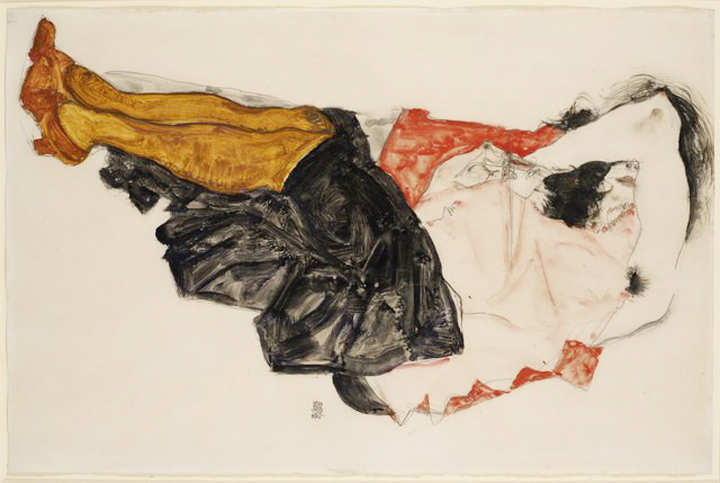Prized Paintings Once Looted by Nazis Must Be Returned to Jewish Collector's Heirs
The decision could have implications for the wider fight by Jewish heirs to reclaim artwork looted en masse from their ancestors by the Third Reich.
April 06, 2018 at 10:42 AM
7 minute read
The original version of this story was published on New York Law Journal

A Manhattan judge on Thursday ordered two highly valued, early 20th century paintings looted by the Nazis returned to the heirs of an Austrian Jewish entertainer who'd first collected them, ruling that “a signature at gunpoint cannot lead to a valid conveyance.”
The decision by state Supreme Court Justice Charles Ramos is the first ruling on the merits in a 2½-year dispute over the paintings that some say could have implications for the wider fight by Jewish heirs to reclaim artwork looted en masse from their ancestors by the Third Reich. Regardless of broader impact, the immediate effect of Ramos' decision is clear: Two prized and somewhat stark paintings, “Woman in Black Pinafore” (1911) and “Woman Hiding Her Face” (1912), estimated to be worth $5 million together and sitting in a Queens warehouse, are now directed to be transferred to the lawsuit's plaintiffs. Although, Richard Nagy, a London-based art dealer and the suit's defendant, said on Thursday through an attorney that he will appeal.
Both art pieces were created by the celebrated Austrian painter Egon Schiele. And it was the heirs' relative, Fritz Grünbaum, who Ramos said on Thursday indisputably owned the pieces before World War II, despite the defendants' protestations otherwise, and who had collected them. He was a songwriter, director, actor and master of ceremonies who openly mocked Hitler during the 1930s, according to Raymond Dowd, the heirs' attorney. And over his lifetime he amassed a 449-piece art collection, 81 of them Schieles. Then in 1938 the Nazis stormed his home and arrested him, leaving his wife behind. He was sent to the Dachau concentration camp where he was forced, perhaps at gunpoint, to sign a power of attorney over his possessions to his wife. Three years later he was murdered at Dachau.
Ramos, in siding with the heirs in a replevin and conveyance case that saw defendants put forward 18 separate defenses, wrote that defendants Richard Nagy and Richard Nagy Ltd. had simply failed to present sufficient evidence, on the merits, in their favor. His ruling addressed summary judgment motions brought by both the plaintiffs and defendants.
“We accept that the Artworks were the property of Mr. Grunbaum, and that the entirety of Mr. Grunbaum's property was looted by the Nazis during World War II,” Ramos wrote, adding, “Confronted with plaintiffs' prima facie case, the burden of proof shifts to defendants to establish they have a superior claim to the Artworks, or to at least raise a triable issue of fact.”
“Defendants have neither presented evidence nor raised a triable issue of fact to show that Mr. Grunbaum voluntarily transferred the subject artworks during his lifetime,” the judge continued. “Although the Nazis confiscated Mr. Grunbaum's artworks by forcing him to sign a power of attorney to his wife, who was herself later murdered by the Nazis, the act was involuntary … A signature at gunpoint cannot lead to a valid conveyance.”
The 17-page opinion, according to plaintiffs' lawyer Dowd, was notable for several reasons, including that Ramos applied the Holocaust Expropriated Art Recovery Act. The Act, adopted unanimously by Congress in 2016, expanded the statute of limitations for heirs of Holocaust victims battling for their family's stolen artwork. The statute's primary intention was to encourage judicial decisions on the merits, rather than on time-based strictures, especially given that Nazi-looted art pieces are often hard to find and sometimes even more difficult to trace back in time.
Ramos not only applied the HEAR Act, despite arguments against it by defendants, he also appeared to look to the act to guide him on how to view the plaintiffs' evidentiary arguments that Grunbaum had rightfully owned the paintings.
“In the HEAR Act, the [1998 Washington Conference] Principles [on Nazi-Confiscated Art], and the Holocaust Victims Redress Act [of 1997], we are instructed to be mindful of the difficulty of tracing artwork provenance due to the atrocities of the Holocaust era, and to facilitate the return of property where there is reasonable proof that the rightful owner is before us,” Ramos wrote.
He also pointed out that “even the [art] Gallery on which defendants rely as the source of their [the paintings'] provenance has confirmed that Mr. Grunbaum had owned the works.”
Dowd said in both a phone interview and statement Thursday that he viewed Ramos' decision as vital to the decadeslong and continuing effort by Holocaust victim's heirs to reclaim their culture and family possessions. He noted the application of the HEAR Act, and also contended that the judicial opinion may help him and his clients lobby or legally force museums, for instance, to return to his clients Grunbaum-collection art pieces that are still being displayed today.
“This decision brought us a step closer to recovering all of the culture that was stolen during the largest mass-theft in history which, until now, has been overshadowed by history's largest mass-murder,” Dowd said.
He also deemed the dispute “probably the most important art case of the late 20thcentury,” as he linked it to former Manhattan District Attorney Robert Morgenthau's landmark maneuver in 1998 to seize Schiele's “Dead City 3” painting—which also came from Grunbaum's vast collection—from the Museum of Modern Art.
“Justice Ramos' decision has ended a controversy [over the correctness of Morgenthau's action] that has raged since the 1998 Morgenthau seizure,” Dowd said.
But Thaddeus Stauber, a Nixon Peabody partner and Nagy's defense lawyer, was quick to point out on Thursday that three other judicial bodies had considered the two Schiele paintings' origins and found they weren't stolen. Moreover, he didn't believe Ramos' decision would have the far-reaching impact professed by Dowd.
He also criticized the ruling.
“As an art dealer with a long record of working with German Expressionist artworks, and someone whose own family had to flee persecution, Richard [Nagy] is particularly sensitive to restitution claims and continues to believe that all such claims call for close and merit-based review,” Stauber said. “We turned to recognized Holocaust provenance experts Sophie Lillie, Laurie Stein, and Lynn Nicholas to vet and issue independent reports on the modern-day claims [regarding the Schiele paintings]. Had any one of them found that the Schiele artworks were owned by Fritz Grünbaum and stolen by the Nazis, Richard would not have hesitated to restitute them. … [I]t is surprising that Justice Ramos ignored not only their [expert] reports, but also the decisions of the U.S. federal court and two independent Austrian panels that previously found that this collection of artworks was not stolen by the Nazis.”
The plaintiffs in the 2015-filed suit, Reif v. Nagy, 161799/15, were Milos Vavra, along with Timothy Reif and David Fraenkel, who are the co-heirs and co-executors of the estate of Leon Fischer. Fischer is descended from Grunbaum's wife's brother and Vavra from Grunbaum's sister, Dowd said.
On April 26, 1938, the Nazis passed the “Decree Regarding the Reporting of Jewish Property,” which required all Jews to declare property valued at or over 5,000 reichmarks, according to Ramos.
The goal was for the Nazis to seize the property to fund their war machine, he added.
In the lawsuit, Nagy has asserted that he and his business possessed good title to the two Schiele paintings. He contended that the Nazis inventoried the Grunbaum art collection but did not steal it and that Grunbaum's sister-in-law legitimately sold 53 of the Schieles to a Swiss art dealer in 1956—a contention Dowd says is false.
Regardless, the paintings changed hands and passed through the art world, until one day in 2015 the plaintiffs spotted the works in Nagy's booth at an art show held in New York's Park Avenue Armory. Days later, Dowd made a demand for their return, kicking off the fight.
“Today, my family has regained a part of its history that was stolen by the Nazi Regime,” said Timothy Reif, one of the heirs, after the opinion was released. “These paintings help us remember and honor the lives of those we love and help us preserve Jewish culture that the Nazis tried so hard to destroy.”
This content has been archived. It is available through our partners, LexisNexis® and Bloomberg Law.
To view this content, please continue to their sites.
Not a Lexis Subscriber?
Subscribe Now
Not a Bloomberg Law Subscriber?
Subscribe Now
NOT FOR REPRINT
© 2025 ALM Global, LLC, All Rights Reserved. Request academic re-use from www.copyright.com. All other uses, submit a request to [email protected]. For more information visit Asset & Logo Licensing.
You Might Like
View All
An ‘Indiana Jones Moment’: Mayer Brown’s John Nadolenco and Kelly Kramer on the 10-Year Legal Saga of the Bahia Emerald


Travis Lenkner Returns to Burford Capital With an Eye on Future Growth Opportunities

Legal Speak's 'Sidebar With Saul' Part V: Strange Days of Trump Trial Culminate in Historic Verdict
1 minute readTrending Stories
- 1'It's Not Going to Be Pretty': PayPal, Capital One Face Novel Class Actions Over 'Poaching' Commissions Owed Influencers
- 211th Circuit Rejects Trump's Emergency Request as DOJ Prepares to Release Special Counsel's Final Report
- 3Supreme Court Takes Up Challenge to ACA Task Force
- 4'Tragedy of Unspeakable Proportions:' Could Edison, DWP, Face Lawsuits Over LA Wildfires?
- 5Meta Pulls Plug on DEI Programs
Who Got The Work
Michael G. Bongiorno, Andrew Scott Dulberg and Elizabeth E. Driscoll from Wilmer Cutler Pickering Hale and Dorr have stepped in to represent Symbotic Inc., an A.I.-enabled technology platform that focuses on increasing supply chain efficiency, and other defendants in a pending shareholder derivative lawsuit. The case, filed Oct. 2 in Massachusetts District Court by the Brown Law Firm on behalf of Stephen Austen, accuses certain officers and directors of misleading investors in regard to Symbotic's potential for margin growth by failing to disclose that the company was not equipped to timely deploy its systems or manage expenses through project delays. The case, assigned to U.S. District Judge Nathaniel M. Gorton, is 1:24-cv-12522, Austen v. Cohen et al.
Who Got The Work
Edmund Polubinski and Marie Killmond of Davis Polk & Wardwell have entered appearances for data platform software development company MongoDB and other defendants in a pending shareholder derivative lawsuit. The action, filed Oct. 7 in New York Southern District Court by the Brown Law Firm, accuses the company's directors and/or officers of falsely expressing confidence in the company’s restructuring of its sales incentive plan and downplaying the severity of decreases in its upfront commitments. The case is 1:24-cv-07594, Roy v. Ittycheria et al.
Who Got The Work
Amy O. Bruchs and Kurt F. Ellison of Michael Best & Friedrich have entered appearances for Epic Systems Corp. in a pending employment discrimination lawsuit. The suit was filed Sept. 7 in Wisconsin Western District Court by Levine Eisberner LLC and Siri & Glimstad on behalf of a project manager who claims that he was wrongfully terminated after applying for a religious exemption to the defendant's COVID-19 vaccine mandate. The case, assigned to U.S. Magistrate Judge Anita Marie Boor, is 3:24-cv-00630, Secker, Nathan v. Epic Systems Corporation.
Who Got The Work
David X. Sullivan, Thomas J. Finn and Gregory A. Hall from McCarter & English have entered appearances for Sunrun Installation Services in a pending civil rights lawsuit. The complaint was filed Sept. 4 in Connecticut District Court by attorney Robert M. Berke on behalf of former employee George Edward Steins, who was arrested and charged with employing an unregistered home improvement salesperson. The complaint alleges that had Sunrun informed the Connecticut Department of Consumer Protection that the plaintiff's employment had ended in 2017 and that he no longer held Sunrun's home improvement contractor license, he would not have been hit with charges, which were dismissed in May 2024. The case, assigned to U.S. District Judge Jeffrey A. Meyer, is 3:24-cv-01423, Steins v. Sunrun, Inc. et al.
Who Got The Work
Greenberg Traurig shareholder Joshua L. Raskin has entered an appearance for boohoo.com UK Ltd. in a pending patent infringement lawsuit. The suit, filed Sept. 3 in Texas Eastern District Court by Rozier Hardt McDonough on behalf of Alto Dynamics, asserts five patents related to an online shopping platform. The case, assigned to U.S. District Judge Rodney Gilstrap, is 2:24-cv-00719, Alto Dynamics, LLC v. boohoo.com UK Limited.
Featured Firms
Law Offices of Gary Martin Hays & Associates, P.C.
(470) 294-1674
Law Offices of Mark E. Salomone
(857) 444-6468
Smith & Hassler
(713) 739-1250






